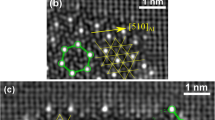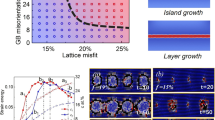Abstract
Microscopic phase field simulation is performed to study antisite defect type and temporal evolution characteristic of D022-Ni3V structure in Ni75Al x V25−x ternary system. The result demonstrates that two types of antisite defect VNi and NiV coexist in D022 structure; however, the amount of NiV is far greater than VNi; when precipitates transform from D022 singe phase to two phases mixture of D022 and L12 with enhanced Al:V ratio, the amount of VNi has no evident response to the secondary L12 phase, while NiV exhibits a definitely contrary variation tendency: NiV rises without L12 structure precipitating from matrix but declines with it; temporal evolution characteristic and temperature dependent antisite defect VNi, NiV are also studied in this paper: The concentrations of the both defects decline from high antistructure state to equilibrium level with elapsed time but rise with elevated temperature; the ternary alloying element aluminium atom occupies both α and β sublattices of D022 structure with a strong site preference of substituting α site.
Similar content being viewed by others
References
Liu J B, Johnson D D, Smimov A V. Predicting yield-stress anomalies in L12 alloys: Ni3Ge-Fe3Ge pseudo-binaries. Acta Mater, 2005, 53(13): 3601–3612
Song Y, Guo Z X, Yang R, et al. First principles study of site substitution of ternary elements in NiAl. Acta Mater, 2001, 49(9): 1647–1654
Xie Z Y, Farkas D. Atomistic structure and lattice effects of vacancies in Ni-Al intermetallics. J Mater Res, 1994, 9(4): 875–883
Lozovoi A Y, Mishin Y. Point defects in NiAl: The effect of lattice vibrations. Phys Rev B, 2003, 68: 184113-1–184113-10
Meyer B, Fähnle M. Atomic defects in the ordered compound B2-NiAl: A combination of ab initio electron theory and statistical mechanics. Phys Rev B, 1999, 59(9): 6072–6082
Besson R, Legris A. Comprehensive ab initio thermodynamic treatment of impurities in ordered alloys: Application to boron in B2 Fe-Al. Phys Rev B, 2006, 74: 094103-1–094103-10
Foiles S M, Daw M S. Application of the embedded atom method to Ni3Al. J Mater Res, 1987, 2(1): 5–15
Johnson R A, Brown J R. Vacancies and antisite defects in ordered alloys. J Mater Res, 1992, 7(12): 3213–3218
Badura-Gergen K, Schaefer H E. Thermal formation of atomic vacancies in Ni3Al. Phys Rev B, 1997, 56: 3032–3037
Fu C L, Painter G S. Point defects and the binding energies of boron near defect sites in Ni3Al: A first-principles investigation. Acta mater, 1997, 45(2): 481–488
Hu Q M, Yang R, Hao Y L, et al. Concentrated point defects in and order-disorder transition temperature of intremetallic compounds. Phys Rev Lett, 2004, 92(18): 185505-1–185505-4
Brown J A, Mishin Y. Monte Carlo modeling of low-index surfaces in stoichiometric and Ni-rich NiAl. Phys Rev B, 2003, 67: 195414-1–195414-9
Mishin Y. Atomistic modeling of the γ and γ′ phases of the Ni-Al system. Acta Mater, 2004, 52: 1451–1467
Wang Y X, Wang B Y, Rong Z W, et al. Study of vacancy migration in NiAl by molecular dynamics (in Chinese). Acta Phys Sin, 1998, 47(8): 1325–1331
Prakash U, Buckley R A, Jones H, et al. D022 to L12 transition in intermetallic systems. J Mater Sci, 1992, 27: 2001–2004
Bendersky L A, Biancaniello F S, Williams M E. Evolution of the two-phase microstructure L12 + D022 in near-eutectoid Ni3(Al,V) alloy. J Mater Res, 1994, 9(12): 3068–3082
Marteau L, Pareige C, Blavette D. Imaging the three orientation variants of the DO22 phase by 3D atom probe microscopy. J Microsc, 2001, 204(3): 247–251
Zapolsky H, Pareige C, Marteau L, et al. Atom probe analyses and numerical calculation of ternary phase diagram in Ni-AI-V system. Calphad, 2001, 25(1): 125–134
Pareige C, Blavette D. Simulation of fcc→fcc+L12+Do22 the kinetic reaction. Scr Mater, 2001, 44: 243–247
Poduri R, Chen L Q. Computer simulation of atomic ordering and compositional clustering in the pseudobinary Ni3Al-Ni3V system. Acta mater, 1998, 46(5): 1719–1729
Zhao Y H, Ju D Y, Hou H. Atomic-scale computer simulation of mixture precipitation mechanism for Ni75AlxV25−x alloy. Mater Sci Forum, 2005: 475–479
Li Y S, Chen Z, Lu Y L, et al. Coarsening kinetics intermetallic precipitates in Ni75AlxV25−x alloys. J Mater Res, 2007, 22(1): 61–67
Chen G L, Lin J P. Ordered Intermetallic of structural materials (in Chinese). Beijing: Metallurgical Industry Press, 1999. 32–36
Cabet E, Pasturel A, Ducastelle F, et al. L12-DO22 competition in the pseudobinary (Pt, Rh)3V, Pt3(V, Ti), and (Pd, Rh)3V alloys: Phase stability and electronic structure. Phys Rev Lett, 1996, 76(17): 3140–3143
Zhao D P, Jing T, Liu B C. Simulating the three-dimensional dendritic growth of Al alloy using the phase-field method (in Chinese). Acta Phys Sin, 2003, 52(7): 1737–1742
Wang Y, Banerjee D, Su C C, et al. Field kinetic model and computer simulation of precipitation of L12 ordered intermetallics from f.c.c. solid solution. Acta mater, 1998, 46(9): 2983–3001
Li Y S, Chen Z, Lu Y L, et al. Dynamic scaling behavior of late-stage phase separation in Ni75AlxV25−x alloys. Chin Phys, 2007, 16(3): 854–861
Chu Z, Chen Z, Wang Y X, et al. Microscopic phase-field simulation of atom substitution behaviour in Ni-Cr-Al alloy. Chin Phys Lett, 2005, 22(8): 1841–1844
Chen L Q, Khachaturyan A G. Computer simulation of structural transformation during precipitation of an ordered intermetallic phase. Acta metal Mater, 1991, 39(11): 2533–2511
Chen L Q. A computer simulation technique for spinodal decomposition and ordering in ternary systems. Scr Metall et Mater, 1993, 29(5): 683–688
Chen L Q. Computer simulation of spinodal decomposition in ternary systems. Acta Metall Mater, 1994, 42(10): 3503–3513
Author information
Authors and Affiliations
Corresponding author
Additional information
Supported by the National Natural Science Foundation of China (Grant Nos. 50671084 and 50875217), the Doctorate Foundation of Northwestern Polytechnical University of China (Grant No. CX200806), the China Postdoctoral Science Foundation Funded Project (Grant No. 20070420218), and the Natural Science Foundation of Shaanxi Province of China
Rights and permissions
About this article
Cite this article
Zhang, J., Chen, Z., Zhang, M. et al. Antisite defect types and temporal evolution characteristics of D022-Ni3V structure: Studied by the microscopic phase field. Sci. China Ser. G-Phys. Mech. Astron. 52, 1154–1160 (2009). https://doi.org/10.1007/s11433-009-0156-4
Received:
Accepted:
Published:
Issue Date:
DOI: https://doi.org/10.1007/s11433-009-0156-4




